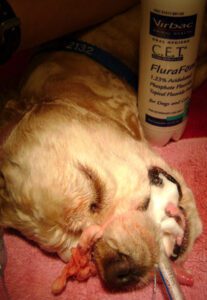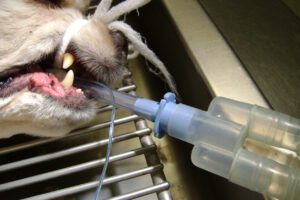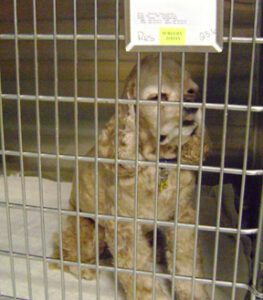Each year, in an effort to raise awareness about periodontal disease in pets, the veterinary industry sets aside the month of February as Pet Dental Month. Pet dentistry is a significant focus at the Ann Arbor Animal Hospital because we know that periodontal disease may result in bacteria being spread throughout your pet’s body, which can lead to other health issues in your pet’s liver, kidneys, and heart.
Periodontal disease is the most common disease in dogs and cats, with an estimated 80%+ afflicted. The good news is that pet dentals are simple and safe making the treatment of periodontal disease relatively easy to treat! We know, and clients have shared numerous examples with us, that pets are healthier and happier when their teeth are clean, their breath is fresh and they don’t have mouth pain.
Here is a letter that we received from one of our clients:
Dear Dr. Figarra and staff at Ann Arbor Animal Hospital,
I am writing to thank you all for the excellent dental care my miniature poodle, Casey Mae, recently received. Due to Casey’s many health concerns I had not given her oral health much attention. I had recently noticed her breath smelling unpleasant and when I touched her gums, they would bleed. I called your office for advice and information. I must admit the cost quoted to me for a dental cleaning and possible extractions seemed a bit steep initially, but Jane, one of your staff, assured me that Casey would receive a “first class” cleaning with pre-op blood work, pre-op premeds, dental x-rays, post-op pain meds all in the included in the cost with the cleaning. She also explained that any extractions would be extra, which I understood.
The day of her dental visit arrived and I elected to remain in the office waiting room while Casey’s teeth were x-rayed, cleaned and evaluated. Dr. Figarra came out twice during the visit to go over her x-rays thoroughly with me. Although I was saddened Casey was to have 5 teeth extracted, Dr. Figarra explained it was best for her overall health and well being, especially since she was approaching her 14th birthday. I picked Casey up late that afternoon with plenty of post-op meds, a “doggie-bag” of dental treats, brush and toothpaste, and written post-op instructions. And of course, a reminder from the staff, to “call ANYTIME, if I have ANY questions because we are ALWAYS HERE”
Casey’s recovery has gone very well! She is eating her normal dry kibble, and running around like a new dog. Although she can’t tell me, I know she feels much better! I can’t thank you and the staff enough for your expertise and caring!
Sincerely, Sue M. (Casey’s mom)
We often say that an educated client is our best client because they know, and have come to understand, that not all veterinary dental procedures are created equal. At the Ann Arbor Animal Hospital each dental procedure includes (if you’re shopping please use this as a checklist so that you’re assured you are comparing “apples-to-apples”):
- Pre-anesthetic blood work
- Monitoring of heart rate, oxygen saturation & blood pressure
- Intravenous catheter & fluids throughout the dental procedure
- Inhalant anesthesia allowing rapid adjustments in anesthetic depth
- Ultrasonic scaling & polishing
- Fluoride application
- Digital Dental radiographs
- Extractions if needed (our DVM will consult with you)
- Optional Ora-Vet Dental Sealant
- Recovery in a warmed kennel
- Free dental kit to take home
Typical dental procedure at Ann Arbor Animal Hospital

While under anesthesia, we closely monitor the patient’s heart rate & oxygen saturation, IV fluids being administered, and blood pressure.

A topical, foam fluoride treatment is applied to help strengthen the enamel by making the crystals that form enamel more durable. Tooth enamel crystals that have fluoride are much more resistant to acid. They are less likely to breakdown and cause the tooth surface to become porous.

Oravet, a plaque prevention sealant, significantly reduces plaque & tartar formation by creating a barrier helping to prevent bacteria from attaching to your pet’s teeth

This is what our patient looks like during the first stage of waking up from anesthesia, moments after the Breathing Tube has been removed
Recent Posts
About Us
Ann Arbor Animal Hospital is a locally-owned animal hospital operating for over 90 years in Ann Arbor, MI.











